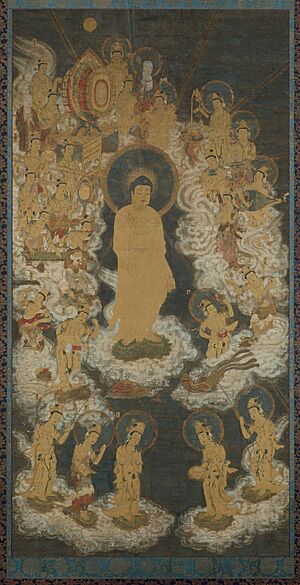Raigō facts for kids
Raigō (pronounced Rye-goh) is a special idea in Buddhism in Japan. It means 'welcoming approach.' It's about the Amida Buddha appearing at the moment someone passes away. The Buddha is often seen coming down on a beautiful 'purple cloud' (called shiun in Japanese).
Contents
What is Raigō?
In Japanese Buddhist beliefs, when a person dies, the Amida Buddha comes to welcome their spirit. This is a comforting thought for many people. The Buddha helps the spirit travel to the pure land, which is like a heavenly place. The most popular idea is that souls go to the Western Paradise.
How Amida Buddha Appears
The Amida Buddha does not come alone. Sometimes, two special helpers called bodhisattvas come with him. This is known as a triad, meaning a group of three. Other times, a very large group of followers comes along. This group can even include musicians playing beautiful, heavenly music.
After arriving, the Buddha lifts the spirit of the person who has died. Then, the Buddha and the spirit go back up to the pure land. This journey is seen as a peaceful and welcoming event.
Raigō in Art
The idea of Raigō led to a special kind of Japanese painting called raigō-zu. These paintings show the Amida Buddha and his helpers coming down from the sky. They are often very detailed and beautiful.
Paintings as Rituals
In the past, these paintings were used in a special way. If someone was close to death, a raigō-zu painting might be brought into their home. It was meant to bring comfort and show the welcoming arrival of the Buddha.
Popularity of Raigō Art
Raigō paintings and sculptures became very popular, especially among wealthy families. They showed the Amida Buddha celebrating and welcoming their dead relatives. Sometimes, these artworks even showed the Buddha coming to the family's own house.
Some of these paintings are examples of yamato-e. This is a style of Japanese painting that often shows Japanese landscapes. Raigō-zu gave artists a chance to paint beautiful scenes of the Japanese countryside.
Images for kids
-
Raigō painting from the late Heian period
-
The Amida welcomes Chûjôhime to the Western Paradise, hanging scroll painting, 16th century, owned by the University of Michigan Museum of Art





